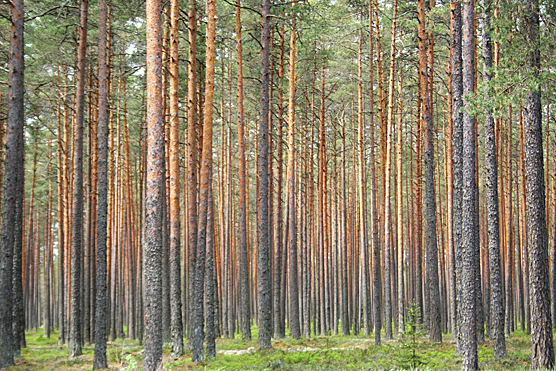Press release 2022-06-15 at 9:11

Based on the study, it was evident that increased harvesting reduced the amount of carbon sequestered in forests compared to a situation where harvesting was not increased. © Photo: Esa Nikunen/SYKE
A fresh review study shows that increased felling reduces carbon sequestered in forests significantly in both boreal and temperate regions. It is often argued that although increased harvesting does reduce carbon sequestered in forests, this is a short-term effect. Based on the new study the impact is significant for at least 100 years.
Achieving the targets of the Paris Agreement requires sharp reductions in CO2 emissions within the next few decades. Most CO2 emissions come from the use of fossil fuels. One way to reduce these emissions is to increase the use of wood in place of non-renewable raw materials.
Wood use impacts carbon stocks in forests, harvested wood products, and fossil fuel reservoirs. The sum of these changes reveals how intensified wood use impacts concentrations of atmospheric CO2.
A new review study shows that increasing the tree harvest significantly reduces carbon sequestration in forests for at least 100 years in both boreal and temperate regions. “On the average the reduction in forest carbon stock is higher than the increase in carbon stocks in harvested wood products and the avoided fossil-based emissions”, says the first author of the study, Head of Unit, Dr. Sampo Soimakallio of the Finnish Environment Institute.
It is often argued that increased wood harvest reduces carbon sequestered in forests but only for a short period of time. Based on the study the carbon stocks are also reduced over a long period. “Contrary to what we expected, there was no significant difference in average values between the changes in carbon stock over short and long time-horizons”, says research scientist Jari Niemi of the Finnish Environment Institute, one of the authors of the paper.
No differences were found between boreal and temperate geographies
Another interesting finding was related to the geographical distribution: “We found no significant differences in our results between data derived from scenario studies covering boreal, and temperate geographies. On average, the effect is very similar in both the regions.”, observes another co-author of the paper, junior researcher Fredric Mosley of the European Forest Institute.
Based on the study, it was evident that increased harvesting reduced the amount of carbon sequestered in forests compared to a situation where harvesting was not increased.
Nitrogen fertilization, genetic improvement of tree species, or an increase in forest area can impact carbon stocks in forests. “These explained the clear outliers in the reviewed data”, explains Niemi. “They may compensate the effect caused by increased harvest, but this does not mean that the increased harvest would not reduce carbon sequestered in forests”, continues Soimakallio.
Impact of harvests has been widely excluded in life cycle assessments
The impact of wood harvest on forest carbon stocks has been largely excluded in life cycle assessment studies. This leads to misleading conclusions on the efficiency of wood use in climate change mitigation. “Our results on the impacts of wood harvests can be used in life cycle assessment if more specific data is not available”, explains the joint first author of the paper, Senior Researcher, Dr. Hannes Böttcher, from Oeko-Institut.
“We carried out a systematic review and extensive literature searches. More than 450 papers were reviewed, but only 45 papers provided useful data about the impact of harvests”, explains co-author Sara Turunen who currently works as Specialist at Tapio Ltd.
“Climate change is considered only in a limited number of scenario studies reviewed. More information is needed on how climate change affects forest carbon stocks under different types of forest management”, says Böttcher.
More scenario studies representing different geographical areas, climatic conditions, forest types, and harvest intensities would be needed.
Further information
Head of Unit, Sampo Soimakallio, Finnish Environment Institute SYKE, Tel: +358 295 251 803, firstname.lastname@syke.fi
Senior Researcher, Hannes Böttcher, Oeko-Institut, Tel: +49 30 405 085 389, H.Boettcher@oeko.de
Closing an open balance: the impact of increased tree harvest on forest carbon (onlinelibrary.wiley.com)